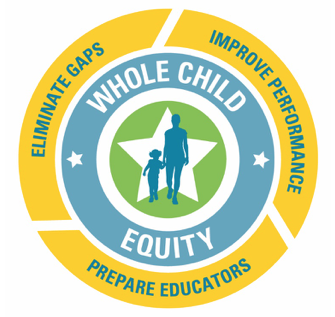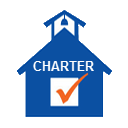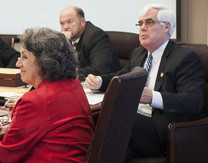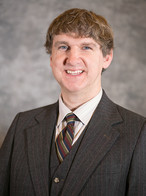
With Leandro Order Pending, State Board Outlines Budget Priorities for 2020-21
Faced with the uncertainties of the state’s initial steps to comply with the most recent Leandro court ruling, the State Board of Education approved a list during its February meeting outlining its budget request that it believes align with those mandates to ensure a “sound, basic education” for all children.
Alan Duncan, chairman of the board’s Business Operations Committee, noted that this year’s process of setting budget priorities differs from past years largely because of Superior Court Judge David Lee’s order last month in the Leandro case that state leaders take decisive steps to improve the state’s education system.
State education and political leaders face a March 30 deadline to provide short-term steps to begin compliance with Lee’s order.
“There are a lot of moving parts and a lot of interested parties,” Duncan told the board. “It’s not going to be possible to be definite in how we try to assess a budget and what our priority needs are. There are going to be other people involved.”
Without a definite target, Duncan said, which in recent years has been set at 2% above the current budget, the board needs to remain flexible.
“But we have a high obligation – including now a legal obligation – to ensure that we are good reporters to the legislature, to the governor and other bodies,” he said. “We need to set out what our needs are.
“Our priorities match with our strategic plan, they match with the WestEd Report (which examined the state’s educational system under the Leandro standards), and with the Leandro Commission report,” Duncan said. “We should put this out as our ask. These are items we see as likely Leandro called-for items and advocate for them.”
Read the full list of budget priorities here.
|

As NC’s Teacher Attrition Rate Declines, Board Looks for Further Improvement
While North Carolina’s overall teacher attrition rate declined for the second year in a row, according to the state’s annual report on the teaching profession, members of the State Board of Education discussed steps this month that might help retain greater numbers of teachers, especially those early in their careers and those with the longest experience.
The percentage of teachers who were no longer teaching in the state’s traditional public or charter schools fell last year to about 7.5%, down from 8.1% for the previous year, and 8.7% three years ago.
“The trend itself is important,” said Tom Tomberlin, director of educator recruitment and support for the Department of Public Instruction. He said efforts to improve the “pipeline” of teachers is the right policy approach by the state, bringing more teachers into the profession, while fewer teachers are leaving it.
“We are not seeing massive exodus from the state,” Tomberlin said. “We see great stability, even decline, in attrition.”
But Tomberlin also presented more detailed data showing differences in attrition rates by years of experience and by differing pathways to teaching, raising questions about how the state’s schools can keep even more teachers in the classroom.
“Can we get more experienced teachers to stay longer,” Tomberlin asked, “and entice them to remain in public education? Are we doing enough to support our beginning teachers for them to feel like they are successful in those initial years and stay connected to the classroom.”
He noted that experienced, licensed teachers who enter the profession through traditional preparation routes have attrition rates below the state average, while beginning teachers have rates “higher than we want.” That’s also the case for lateral-entry – now residency – teachers, he said.
“This is becoming the traditional pathway to teacher licensure,” Tomberlin said. “This number must be addressed. This is going to represent the vast majority of our teachers coming into the profession.”
He also presented data showing that teachers who are more effective are less likely to leave compared to less effective teachers.
Board members asked what steps the state might take to change such outcomes.
“None of us like to do a job that we’re not good at,” said member Jill Camnitz. “What are we doing to reach out to those teachers who aren’t effective to make them more effective so they’ll stay with us?”
Member JB Buxton said efforts should be addressed at both ends of the experience range to improve retention of both beginning and highly experienced teachers.
“How do we create mentoring roles that assist LEAs?” Buxton asked, “and at the other end, what are incentives we can work on with the General Assembly to think about retiree rehiring and keeping late-year teachers who are still very good in the profession?”
|

State Board Considers Revisions to Rules on Contracts; State and Federal Funding
Board members this month reviewed policies that would reduce the amount that that the state superintendent can approve for contracts without the board’s authorization and also would require detailed budget reports from the superintendent.
Under current board policy, the superintendent can approve contracts less than $1 million without state board endorsement. A revision to that policy, to be considered for approval by the board next month, would set that maximum at $500,000 except for emergency reasons.
Alan Duncan, chairman of the board’s Business Operations Committee, said the board had initially set the contract limit at $1 million because it was concerned that it might be overburdened by contracts of lesser amounts. “But we have not seen many contracts between $500,000 and $1 million,” Duncan said.
In the case of emergency contacts, the policy revision adds language requiring the state superintendent or designee to provide prior notice to the board chairperson, if time allows, and in any case that written explanation of the emergency justification be provided to the board.
Duncan explained the proposed change aligns board policy with statutory language for emergency contracts.
The board is also considering adopting a policy outlining the supervision and administration of state and federal funds for the state’s public schools. Among the key requirements are these:
- At least annually, the state superintendent shall present for the board’s review and approval a proposed budget for the Office of the Superintendent, the Department of Public Instruction, the N.C. State Public School Fund, and any other state or federal funds allocated for the benefit of the State’s public school system.
- The superintendent’s budget recommendations shall reflect and support the board’s priorities, as articulated in its vision, mission, goals, and strategic plan, and also sets forth recommended expenditure requirements, funding sources, and performance information for each program and for each proposed capital improvement.
- The budget will also show the amount spent in each division for the most recently completed fiscal year, the amount budgeted for each division for the current fiscal year, and the amount recommended for the next fiscal year for the department’s budget.
- Additionally, the budget will include brief explanations of proposed increases and/or reductions of funds to be allocated to programs.
Board member JB Buxton said the proposed policy would help better define the relationship between the Department of Public Instruction and the board.
“It positions a working relationship and a clarity and transparency and an accountability around the use of funds against the plans and goals and expectations of the board,” Buxton said.
He also proposed adding a provision to help ensure that funds appropriated by the General Assembly or the federal government are spent for their intended purposes.
“So that funds appropriated by those bodies must be spent for those purposes and if there is a different way those funds are going to be expended, then the department and the board should be on the same page,” Buxton said. “I don’t think that cuts down any flexibility. I think that keeps us on the right side of the law.”
|

Board Approves Annual Charter School Report and Charter Renewals
The State Board approved a revised annual charter school report following discussion about making future reports more “data driven” and less qualitative and also providing more information about the impact of charters on traditional schools in future reports.
Board member Alan Duncan said that he wanted the report to include greater focus on data about the schools and what that data says.
“There were a number of things in the report that were less data driven and more qualitative, at best, kinds of assessments,” Duncan said. “I have concerns about some of those qualitative things that are subject to discussion or debate. If we can focus on what the data tells us, that’s what’s important. That’s our obligation to report to the General Assembly.”
Member Jill Camnitz said she wanted more information about the effects of charter schools on the districts where they’re located and their impacts on traditional schools.
“It’s my understanding that the report was supposed to include information about the impact of charters on the delivery of services by traditional public schools, and I don’t see that topic particularly well addressed in the report,” Camnitz said. “I think there’s some evidence that there may be some negative impacts on some LEAs, and I think that’s something we should be talking about.”
The board approved charter renewals for 18 schools, ranging from three to 10 years. The renewal for one of the schools, Kestrel Heights School in Durham, was granted a five-year renewal instead of 10 years, based on a recommendation from DPI’s Office of Charter Schools.
Amy White, chairwoman of the Education Innovation and Charter Schools Committee said that while she believes that Kestrel Heights has made good progress in the wake of several non-compliance issues, the renewal approval should cover a shorter time period.
“Ten years gives me great pause because I think it’s incumbent on this board to make sure that we provide the proper oversight – not only over financial and operating compliance but student success,” White said.
|
Board Wants Revisions to Accountability Plan for Educator Preparation Programs
In approving a report to the General Assembly about the development of a “weighted model” accountability plan for the state’s educator preparation programs, the board called for changes to the plan to emphasize the importance of student diversity and performance on licensure exams.
As proposed, a component of the proposed plan holding schools accountable for the enrollment of students by race, gender and socioeconomics would be delayed for at least a couple of years to gather data. But board members asked that programs be held accountable for that measure from the start as a way to increase the numbers of teachers of color, including black males, in the state’s public schools.
Doing less, said board member James Ford, “doesn’t match the urgency of the problem.”
“What are the actionable steps that we’re going to take,” Ford asked. “EPPs [educator preparation programs] have agency over who they recruit. … I want to apply to some pressure – to say that we have to do better as a state. You have to set metrics for a goal and hold yourself accountable for that goal.”
Board member JB Buxton said the accountability model, as proposed, also gives insufficient weight to the performance of education graduates on exams the state requires for teaching licenses. Currently, the exams are weighted equally with teacher evaluations and the growth and performance of students. Buxton said that EPPs have the greatest direct influence over teacher exams and consequently should have greater weight in the model.
“I’d like to see that have a larger role in this,” Buxton said. “We need a tougher accountability system to start.
“This isn’t just about EPPs and their reputation. This is about messages to presidents or chancellors about their focus and the priority of these institutions to help these institutions do what they need to. It’s messages to the General Assembly and the governor about the importance of investment in these areas.
“We’re trying to create leverage for improvement and an accountability system that does that.”
Study Group Recommends Changes to Accountability System; School Performance Grades
Board Sends Report to the General Assembly
A study of North Carolina’s accountability system ordered by the General Assembly last year has reached preliminary conclusions that the state should broaden its measures of school performance and to rely less exclusively on student achievement on year-end exams. The board approved a report on the study's efforts so far and referred it to the General Assembly's Joint Legislative Education Oversight Committee.
The study, conducted by the Southern Regional Education Board (SREB), includes feedback from a work group comprised of teacher, principal and local superintendent representatives, staff from the governor’s office, DPI, the State Board of Education and other partner representatives.
Presenting the study group’s overall feedback so far to the board this month, Dale Winkler, vice president for school improvement at SREB, told state board members that the use of multiple measures, reported separately, would allow schools to better identify their progress and prioritize their next steps.
Winkler also said that the working group sees an urgent need to address the current weighting of the two measures [achievement and growth] that are used to assign A-F school performance grades.
He said the working group concluded that “labeling schools as failing does not communicate the context or the school or the progress made by the students.”
Compared to other states, Winkler said, just North Carolina and Vermont are alone is assigning the greatest weight to student achievement in their school accountability systems. Most states, he said, count student achievement at 40 percent of a school’s performance, and most use more than just two measures.
Other states, such as Ohio, provide separate grades on specific components of school quality, including achievement, progress, gap closing, graduation rate and college and career readiness.
Mariah Morris, the N.C. Teacher of the Year who serves as the teacher advisor to the State Board, said the study group she worked with favors as short-term fixes reporting student achievement and growth as separate measures.
“That would provide a better understanding of why a school is not doing well based on proficiency,” Morris said, “but parents might feel more comfortable sending their children to a school this is doing very well with growth.”
Morris also said her group recommends changing the A-F designations to the same numerical 1-5 scale used with EOG and EOC exams. “That takes away the stigma of a school having an F or a failing grade,” she said.
Matthew Bristow-Smith, the N.C. Principal of the Year and also an advisor to the board, echoed Morris on the issue of A-F grades.
“Our group had real trouble with the idea that we ever apply an F rating to a school,” Britow-Smith said. “If a school has gotten to a point that they have an F rating, we as a state have failed that school. We haven’t provided enough resources. We haven’t had equitable funding to recruit high-quality teachers. Our ADM model doesn’t serve the needs to those schools and we know that schools don’t all have the same needs and yet we continue to apply equal measures to them.
“At some point,” he said, “we have to be able to tell the story of schools that are working against all odds to do amazing work and to elevate the metrics to tell that story.”

State Board Honors Former Members Trisha Willoughby and Wayne McDevitt
Current State Board members honored former board veterans Trisha Willoughby and Wayne McDevitt, who each served 18 years on the board. They both retired from the board last year after new members, Donna Tipton-Rogers and J. Wendell Hall, were confirmed by the General Assembly.
Board Chairman Eric Davis described them as “champions of public education – perhaps the greatest-of-all-time champions of public education” for each having served two eight-year terms plus two additional years.
“Tens of thousands of our students and every North Carolinian have been the beneficiaries of the tireless, selfless and dedicated services of our two champions,” Davis said. “The example they have set for all of us behooves us to rededicate ourselves to their cause – which is ensuring, defending and expanding the right to every North Carolinian to a sound, basic education.”
|

Board Names Teacher Leader Freebird McKinney as Legislative Affairs Director
The State Board this month named Freebird McKinney, the 2018 Teacher of the Year, to the position of the board’s director of legislative affairs and community outreach.
McKinney succeeds Cecilia Holden, who left the position late last year to become president and CEO of myFutureNC. Prior to being named teacher of the year, McKinney was a teacher at Williams High School, in the Alamance-Burlington School System, where he taught World and European history and also was co-coordinator of the school’s International Baccalaureate Pathway Program. He began his teaching career at Eastern Guilford High School and later taught at Grimsley High School in Greensboro, where he was chairman of the social studies department and taught IB Philosophy and AP European History, among other courses.
After graduating from UNC Chapel Hill with a bachelor’s degree in anthropology in 1998, he earned a second bachelor’s degree in history from UNC Greensboro in 2004, then a master’s degree in education in 2006, also from UNC Greensboro.
|
|